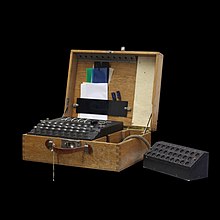Enigma-K
The Enigma-K (also: Enigma K or Enigma Model K ) is a model of the Enigma rotor key machine .
history
In the long history of the different Enigma models , the Enigma-K, introduced in 1927, was the fifth model in chronological terms (see also: family tree of the Enigma under web links ). Like its direct predecessor models , the Enigma-C from 1924 and the Enigma-D introduced in 1926 , the Enigma-K was an "incandescent lamp machine", so it used incandescent lamps for output (and not type levers like models A and B). Compared to the Enigma-D, the Enigma-K showed only minor practical improvements and was cryptographically almost identical to it. At the same time, it was one of the most commercially successful Enigma models and was specially modified upon customer request. Keys and lamps were in the even then for typewriters and today for keyboards usual qwertzu assignment arranged. With the exception of the previous model C and the later Enigma-Z , all Enigma models had this arrangement for buttons and lamps:
Q W E R T Z U I O
A S D F G H J K
P Y X C V B N M L
The reversing roller (VHF) , which was still permanently installed in the C model, could be manually set to one of 26 different positions (A – Z) on the Enigma-K (as well as on the Enigma-D), similar to its three rotating rollers can be set. The VHF was “settable”, but did not rotate with the key process. The rotating rollers were now on a removable axle. This made it possible to easily change the “roller position” , i.e. the sequence of the three rotating rollers within the roller set. Three rollers result in 3 * 2 * 1 = 6 possible different roller positions. The key space of the Enigma-K is calculated from the product of the 6 roller layers and the 26 4 different roller positions (for VHF and the three rotating rollers) to 6 × 456,976 = 2,741,856 or about 21 bits . The exact wiring of the rollers is given in the Roller Wiring chapter of the article on the Enigma rollers .
variants
Swiss Enigma-K
In 1938 the Enigma-K was specially modified for the Swiss Army . It received an additional external lamp field, called a remote reading device, and a separate power supply. The Swiss rewired the rollers and changed the roller wiring of their machines every three months.
Enigma-KD
The Enigma-KD (also: KD Enigma) was in principle an Enigma-K, i.e. a plugless three-roller machine. There was a choice of six newly wired rollers, each with nine transfer notches . As essential cryptographic innovation the engine via a wired up FM, called possessed reverse roller D .
The use of the machine was first observed by the Allies on December 3, 1944. It served the " Military Office " (Mil Office) in the Reich Security Main Office (RSHA) to encrypt radio messages and was used between the German military attachés in Madrid or Lisbon and the OKH in Berlin.
Enigma-T
The Enigma-T (Tirpitz machine), which was put into operation in 1943 and was specially designed for communications between the two war allies Germany and Japan , can also be seen as a variant or successor to the Enigma-K. Characteristic here is the use of rollers with five transfer notches (see also: transfer notches of the Enigma-T ).
literature
- Friedrich L. Bauer : Deciphered Secrets. Methods and maxims of cryptology. 3rd, revised and expanded edition. Springer, Berlin et al. 2000, ISBN 3-540-67931-6 .
- Friedrich L. Bauer: Historical Notes on Computer Science . Springer, Berlin 2009, ISBN 3-540-85789-3 .
- David H. Hamer , Geoff Sullivan , Frode Weierud : Enigma Variations - An Extended Family of Machines . (PDF; 0.1 MB) In: Cryptologia , Vol. 22 (3), July 1998, pp. 211-229; accessed March 4, 2016.
- Louis Kruh, Cipher Deavours: The Commercial Enigma - Beginnings of Machine Cryptography . (PDF; 0.8 MB) In: Cryptologia , Vol. 26 (1), January 2002, p. 1; accessed March 3, 2016.
- Heinz Ulbricht: The Enigma cipher machine - deceptive security. A contribution to the history of the intelligence services . (PDF; 4.7 MB) Dissertation, Braunschweig 2005.
Web links
- Enigma-K in the Crypto Museum (English); accessed March 3, 2016.
- Swiss Enigma-K in the Crypto Museum (English); accessed March 3, 2016.
- Enigma-KD in the Crypto Museum (English); accessed March 3, 2016.
- Enigma Family Tree Family tree of the Enigma (English); accessed March 3, 2016.
Individual evidence
- ↑ Louis Kruh, Cipher Deavours: The commercial Enigma - Beginnings of machine cryptography . (PDF; 0.8 MB) In: Cryptologia , Rose-Hulman Institute of Technology, Taylor & Francis, Philadelphia PA 26.2002,1 (January), p. 7. ISSN 0161-1194 ; accessed March 3, 2016.
- ^ Notes on German High Level Cryptography and Cryptanalysis . ( Memento from June 11, 2014 in the Internet Archive ) (PDF; 7.5 MB) Army Security Agency, European Axis Signal Intelligence in World War II, Vol 2, Washington (DC), 1946 (May), p. 76; Retrieved Nov. 4, 2013.
- ↑ David H. Hamer, Geoff Sullivan, Frode Weierud: Enigma Variations - An Extended Family of Machines . Cryptologia. Rose-Hulman Institute of Technology. Taylor & Francis, Philadelphia PA 22.1998, 1 (July), p. 9, ISSN 0161-1194 . cryptocellar.org (PDF; 80 kB) accessed on November 2, 2018.



